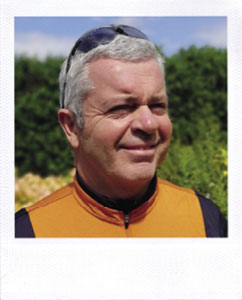When COVID restrictions lift we will see more people return to work, in the high street, the office and service sectors. But how will we get to work? What’s our route? Urban environments are likely to have more, not fewer traffic restrictions – so public transport or walking or riding a bike will be the main option for many of us. What can FMs and workplace professionals do to make different, healthy and safe routes to work more accessible for everyone?
 THE ACTIVE TRAVEL EXPERT’S VIEW
THE ACTIVE TRAVEL EXPERT’S VIEW
NEIL WEBSTER,
DIRECTOR OF REMIT CONSULTING AND FOUNDER OF CYCLO CONSULTING
The most obvious action is to check that your workplace’s end of trip facilities for active travellers are of sufficient quality and quantity. Every indication is that more people will be making active travel choices, partly veering away from public transport but also taking advantage of improved infrastructure. I have seen evidence to show that in places there will be a 20-50 per cent increase in cycle commuting post lockdown. We have undertaken building portfolio reviews that allow occupiers to invest in the right things in the right place to meet their local demand, rather than one size fits all.
But a few grey bike racks are not enough. Cycle parking for a range of bikes (pedal, eBikes, e-Scooters, cargo bikes, etc) plus good-quality showers, lockers, changing facilities and drying rooms are needed. And this is not unique to London, which some people think, as our ReTour series has shown.
You might also think about regular utilisation studies. Dedicating spaces and lockers to people who only come in once a week is not efficient. There are various ways of managing the demand, as with agile working, such that there is not an over-provision of amenities.
Then provide advice and route information to employees. There are some great online route planners out there (Cycle Streets, Komoot, etc) but there is no substitute for good local knowledge. Quorum Park in Newcastle is a great example where the “tenant and travel” advisor has provided information and insight for tenants on the business park.
Safer, quieter routes, albeit slower, might be the best for new starters. New infrastructure, providing segregated cycling, may now be in place in your area as a result of the Government’s Emergency Active Travel Fund. And to quote the CBI/KPMG report “local authorities that will receive these funds should engage in closer dialogue with employers, mapping out how investment can facilitate greater uptake amongst their staff”. A role for FMs?
As some people will be new to cycling, advice should extend to getting started safely – what bike to choose, cycle safety training, what kit to wear, maybe driving part way and cycling the rest, etc. There are some great local groups like the London Cycling Campaign, Camcycle (Cambridge), Walk Ride GM (Greater Manchester), Newcastle Cycling Campaign and many others where you can turn to for advice.
All this points to a sense of community. Creating active travel groups in your workplace allows the commuters’ views and needs to be heard. They are often able to come up with simple costs effective solutions for the FMs, and it keeps them in the loop and valued. Again, there are simple ways of doing this from face-to-face meetings to WhatsApp groups, Yammer and other online platforms.
Provide bike maintenance either on site or a mobile mechanic. This takes the hassle away for the individual and makes the commute a much more pleasurable experience. Some employees will much prefer the on-site solution rather than messing with an oily chain in their front room!
And remember to keep this inclusive. Active travellers take many forms – not all are hardened, long term cyclists. Some have only just started. So, above all, keep the engagement going as evidence suggests that continued support sustains active travel well beyond the early gimmick phase. And remember active travel takes all forms – cycling, running, walking and, in one case in Munich, swimming to work!
 THE URBAN INFRASTRUCTURE EXPERT’S VIEW
THE URBAN INFRASTRUCTURE EXPERT’S VIEW
MEGAN SHARKEY,
MANAGER, WALKING AND CYCLING AT TRANSPORT FOR NSW
The transport revolution is upon us. COVID has highlighted the many ways transport utilises space in our cities. It has reorganised the way we move when physical distancing is required. COVID has also invigorated the discussion on the potential of the more frequent challenges our cities will face, from diseases to energy constraints which affects our health and life activities. It has shown that walking, riding a bike, or other forms of micro-mobility will be a necessity for resiliency and sustainability of life. There are a few things FM and workplace professionals can do to engage and facilitate healthy and safe routes for their employees and business requirements. Historically a lot of this has focused on behaviour change, however this is only a small piece of the puzzle, infrastructure matters more.
The first is to create parking for riding bicycles, scooters, or other micromobilities. If someone can’t park safely, securely or without it being rained on, then they are unlikely to leave it during their working hours. The good news is that you can fit up to 20 folding bikes, 12 standard bikes, or six cargo or accessible bikes in one motor vehicle parking space. Changes in parking can create changes in your business, for example, if you lease space you could potentially convert or reduce car parking spaces leased in a building; you could repurpose car parking for a different paid usage such as floor or storage space; or improve your sustainability rating. Creating parking includes end of trip facilities, e.g. locker and shower facilities. Many have started lockers with hot desking practices; however showers, freshen stations, and different types of lockers allow for more active and different types of activities. This promotes a workplace culture and extends to corporate practices and leadership, for examples, when ordering courier services, supporting cargo-bike deliveries, or providing incentives for bike purchases or loan schemes. These things create a culture that encourage healthy environments.
The second is to support active transport infrastructure. National and local governments have been planning rapid pop-up infrastructure, as well as, short and long-term changes to enable walking, biking, and public transport for sustainable cities. Segregated cycle-lanes, low traffic neighbourhoods, or car free routes are a few examples. Publicly supporting this infrastructure either through public consultation processes, media, or advocacy organisations is key to ensuring governments know they have business support as well. Support is not unprecedented, for example, previously businesses would support road developments or rail projects to enable movement of people and goods. Without public business support this won’t happen, and healthy and safe routes will be sporadic rather than the norm.
Facility managers and workplaces have a role to play in infrastructure change particularly with parking, end of trip facilities, and workplace culture. Being part of a broader coalition though, will help create the healthy and safe routes that are accessible to all on the high street, in offices, or to services both now and with any future restrictions.




